Will an aarti a day save the Yamuna?

The ceremony
- AAP organised a Yamuna aarti last week
- It believes that worshipping the river would make people respect it and keep it clean
Startling numbers
- Yamuna provides more than 70% of Delhi\'s water supply
- Delhi generates 1,900 million litres of sewage each day
- 630 million litres of untreated sewage enters the river every single day
More in the story
- How big is the problem?
- Will conducting Yamuna aarti make any difference?
Last Friday saw many curious Dilliwallas coming to check out the Yamuna river's Kudesia and Gita Ghat in the Capital which was being decorated with sand sculptures and lights. This stinking brackish water, which has over time become a drain to the city's pollutants and sewage waste, was going to be worshiped in pomp and style by none other than Chief Minister Arvind Kejriwal himself.
The idea, inspired from the famous Ganga aarti in Benaras, was to begin a tradition of performing daily evening aartis to the Yamuna. If people worshiped the river, they would respect it. And with respect and reverence would come the need to protect and keep it clean.
Also read - Yamuna will be revived in five years: Arvind Kejriwal
In a country like India where religious sentiment runs high, the Aam Aadmi Party government felt that invoking the Hindu sentiment of worshiping the Yamuna might help boost an ongoing environment campaign. Kejriwal has promised that the Yamuna will be revived in five years.
But are people buying it? And even if the daily prayers eventually attract many worshipers, will it help breathe life into the Yamuna?
The problem
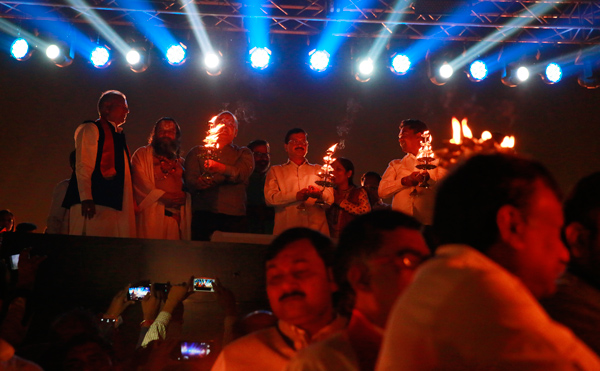
Photo: Vikas Kumar/Catch News
"I didn't even know this was the Yamuna river. I always thought it was a drain behind my house," says 26 year old Nisha Sharma, who is a company secretary and a volunteer with the AAP.
The Yamuna is the longest and second largest tributary river of the Ganges. Originating from the Yamunotri glacier, it gushes down 1,376 kilometers, passing through Delhi, only to join the Ganga at the Triveni Sangam in Allahabad.
The Yamuna is a water life line in Delhi accounting for more than 70% of Delhi's water supplies.
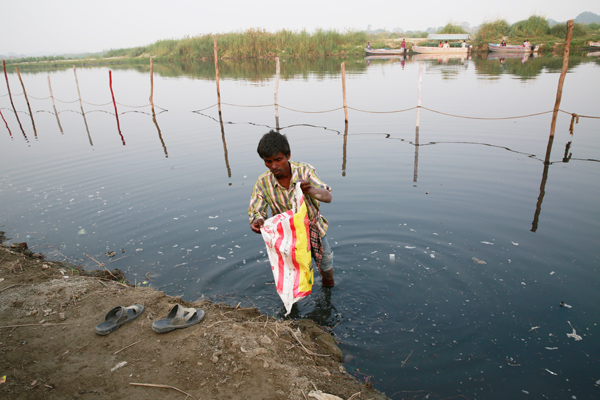
Photo: Vikas Kumar/Catch News
Surprisingly, this doesn't stop Delhi from using it as a drain to empty the city's industrial and chemical waste.
Of the 52 kilometres of the Yamuna in Delhi, the 22 kilometer stretch between Wazirabad and Okhla is the most polluted.
Delhi generates 1,900 million litres of sewage each day. It has an installed waste water treatment capacity of only 1,270 million litres. So 630 million litres of untreated sewage enters the river every single day. The Wazirabad barrage lets out very little water into the river so in summer months especially, the only flow downstream of Wazirabad is of industrial and sewage effluents. This makes it worse particularly for the 3.5 lakh people living in the 62,000 jhuggis on the Yamuna river bed and its embankments.
A river infused with meaning
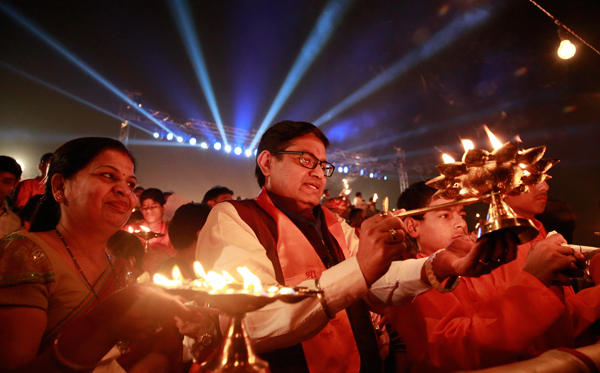
Photo: Vikas Kumar/Catch News
It is written in riveting detail in Hindu scriptures that during the final epoch of this planet, known as Kali Yug, a sign of the impending apocalypse is when the rivers run dry and the drains gush in its place. It seems apt when you see what the Yamuna has come to today.
Mythologically, Yamuna is the Sun God Surya's daughter and Yama's sister who was brought down from the heavens to bring life to this planet. She famously parted her waters for baby Krishna to be carried across to the other side of the bank when he was born. Today eating a single fish from the Yamuna could kill you. A dip in it would leave your skin and eyes burning.
The AAP govt feels that if people worship the Yamuna, they would respect it and keep it clean
"It isn't the Yamuna that is dirty. She is pure as ever. It is us humans who have destroyed her. The aarti is the start to undo our wrongdoings,"says Swami Atmanand ji from the Sanyas Ashram in Varanasi who has come to Delhi to witness the prayer.
But the Ganga has been having an aarti for so many years and hasn't become any cleaner. Why will the Yamuna become any cleaner?
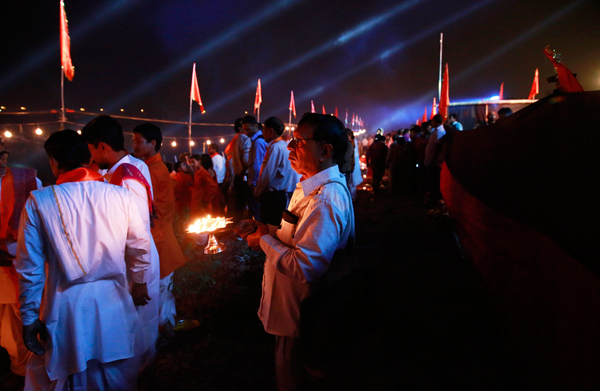
Photo: Vikas Kumar/Catch News
"That Bhav or inner conviction to keep it clean will emerge from the aarti. Ganga too will become cleaner with Modi ji's efforts," says Swami Atmanand ji optimistically.
65 year old Syed, a medical compounder, has come from Azad Market to offer his respects to the river. He has wonderful memories of riding up the Yamuna in a boat to Agra.
He doesn't feel unwelcome that this is a largely Hindu worship decked with saffron flags, resonating with mantras.
"For Delhi the Yamuna is the equivalent of Mumbai's Chowpatty and Juhu beach. It isn't only for the Hindus. This is where people used to come to relax, unwind and have a picnic," says Syed hoping that the tourism will help revive not just the river, but one of Delhi's oldest entertainment destinations.
"We don't mind showing our support to this move by coming to read our Namaaz here if we're asked to," he says smiling calling himself "Kattar Dilli ka, kattar Musalman, kattar Hindustani".
Difficult conversations

Photo: Vikas Kumar/Catch News
But how much will a few people worshiping the river change anything? It is naive for the government to make its people believe that Yamuna, like other polluted rivers, is the result of a few hundred individuals defecating on its banks or throwing their trash into it.
"But if they start telling companies to not pollute the river, where will the companies go? They will have to shut down operations no?" asks Suhas, a high school student, who lives across the Yamuna. He says proudly that he came last Ganesh Chaturti to the submerge his eco-friendly ganesha into the Yamuna.
Yamuna provides 70% of Delhi's water supply. Yet it is used as a drain for the city's waste
The AAP has promised to clean the river in 5 years. For all the capital's sewage and waste to be treated before releasing it into the Yamuna, estimates suggest the AAP needs Rs 50,000 crore to invest in expensive technology.
Is there an adequate plan in place?
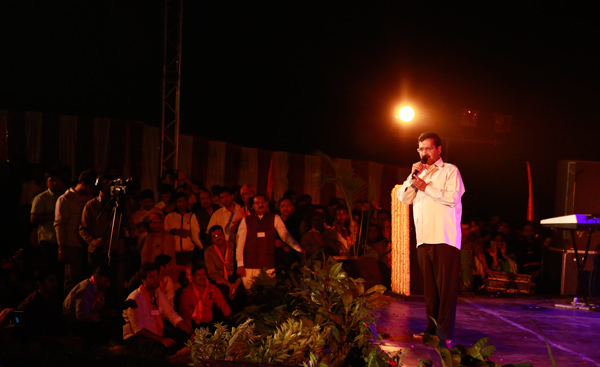
Photo: Vikas Kumar/Catch News
On 13 November, the day of the inaugural aarti, women dressed in green and blue dance on the stage to songs about the Yamuna, the freshly polished brass aarti plates are lit with camphor and aromas of incense sticks waft in the air, as prayers are uttered from the Bible, Quran, Guru Granth Sahib, Kalpasutra and Geeta, as the brass bells are being clung and fire lamps are waved into the night, the river, with its mildly ripe stench fills your nostrils.
It occurs to you that to infuse divinity into this man made beast could take a life time. Hopefully better sense will prevail and AAP ki sarkaar will see that the answer to a clean Yamuna lies in the tough policy decisions that is bound to upset many. Prayers alone would lead us nowhere. As they say, God helps those who help themselves.
READ MORE - Unholy mess: idol immersion is laying waste to the Yamuna
First published: 16 November 2015, 8:29 IST






![BJP's Kapil Mishra recreates Shankar Mahadevan’s ‘Breathless’ song to highlight Delhi pollution [WATCH] BJP's Kapil Mishra recreates Shankar Mahadevan’s ‘Breathless’ song to highlight Delhi pollution [WATCH]](https://images.catchnews.com/upload/2022/11/03/kapil-mishra_240884_300x172.png)

![Anupam Kher shares pictures of his toned body on 67th birthday [MUST SEE] Anupam Kher shares pictures of his toned body on 67th birthday [MUST SEE]](https://images.catchnews.com/upload/2022/03/07/Anupam_kher_231145_300x172.jpg)






